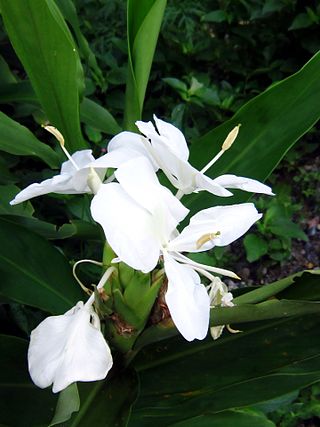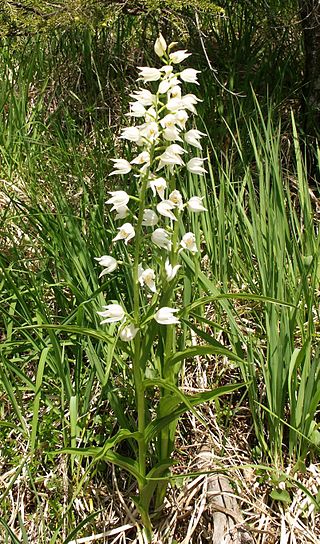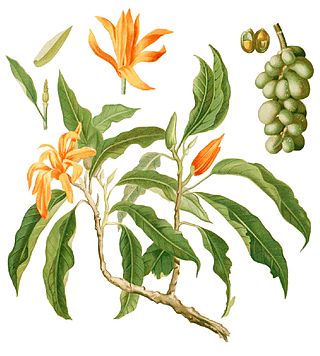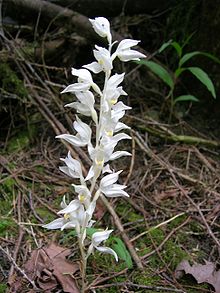
Calypso is a genus of orchids containing one species, Calypso bulbosa, known as the calypso orchid, fairy slipper or Venus's slipper. It is a perennial member of the orchid family found in undisturbed northern and montane forests. It has a small pink, purple, pinkish-purple, or red flower accented with a white lip, darker purple spottings, and yellow beard. The genus Calypso takes its name from the Greek signifying concealment, as they tend to favor sheltered areas on conifer forest floors. The specific epithet, bulbosa, refers to the bulb-like corms.

Hedychium coronarium, the white garland-lily or white ginger lily, is a perennial flowering plant in the ginger family Zingiberaceae, native to the forest understorey of Asia.

Cephalanthera rubra, known as red helleborine, is an orchid found in Europe, North Africa and southwest Asia. Although reasonably common in parts of its range, this Cephalanthera has always been one of the rarest orchids in Britain.

Corallorhiza maculata, or spotted coralroot, is a North American coralroot orchid. It has four varieties: C. maculata var. occidentalis, C. maculata var. maculata, C. maculata var. mexicana, and C. maculata var. ozettensis. It is widespread through Mexico, Guatemala, Canada, St. Pierre & Miquelon, and much of the western and northern United States. It grows mostly in montane woodlands.

Cephalanthera, abbreviated Ceph in horticultural trade, is a genus of mostly terrestrial orchids. Members of this genus have rhizomes rather than tubers. About 15 species are currently recognized, most of them native to Europe and Asia. The only species found in the wild in North America is Cephalanthera austiniae, the phantom orchid or snow orchid. Ecologically, this species is partially myco-heterotrophic. Some of the Eurasian species hybridise.

Cephalanthera longifolia, the narrow-leaved helleborine, sword-leaved helleborine or long-leaved helleborine, is a rhizomatous herbaceous perennial plant in the family Orchidaceae. It is native to light woodland, and widespread across Europe, Asia and North Africa from Ireland and Morocco to China. This includes the United Kingdom, Iran, Russia, Kazakhstan, Turkey, Algeria, India, Pakistan, Germany, Italy, France, Spain, Portugal and many other countries.

Dicentra formosa is a species of flowering plant in the poppy family, Papaveraceae. With its fern-like foliage and inflorescence of drooping pink, purple, yellow or cream "hearts", this species is native to the United States' Pacific Northwest and West Coast of North America.

Magnolia champaca, known in English as champak, is a large evergreen tree in the family Magnoliaceae. It was previously classified as Michelia champaca. It is known for its fragrant flowers, and its timber used in woodworking.

Plumeria obtusa, the Singapore graveyard flower, is a species of the genus Plumeria (Apocynaceae). It is native to the Neotropics, but widely cultivated for its ornamental and fragrant flowers around the world, where suitably warm climate exists.

Erythronium revolutum is a species of flowering plant in the family Liliaceae which is known by several common names, including mahogany fawn lily, coast fawn lily, and pink fawn lily. It is native to the west coast of North America.

Erythronium oregonum is a North American species of flowering plant in the lily family which is known by the common name giant white fawnlily or Oregon fawn-lily.

Corallorhiza mertensiana, or Pacific coralroot, is a coralroot orchid native to the shady conifer forests of northwestern North America. It also goes by the common names Western coralroot and Mertens' coralroot. Corallorhiza mertensiana was previously considered a subspecies of Corallorhiza maculata but was given species rank in 1997 by Freudenstein.

The Mokelumne Wilderness is a 105,165-acre federally designated wilderness area located 70 miles (110 km) east of Sacramento, California. It is within the boundaries of three national forests: Stanislaus, Eldorado and Toiyabe. First protected under the Wilderness Act of 1964, the Mokelumne's borders were expanded under the California Wilderness Act of 1984 with the addition of 55,000 acres. The wilderness takes its name from the Mokelumne River, which was named after a Mi-wok Indian village located on the riverbank in California's Central Valley.

Goodyera pubescens, the downy rattlesnake plantain, is one of the most common orchids native to eastern North America. It is found from Florida to Nova Scotia, west to eastern Oklahoma, Minnesota and Ontario.

Cephalanthera damasonium, the white helleborine, is a species of orchid. It is widespread across much of Europe, the Middle East and Asia. Cephalanthera damasonium is the type species of the genus Cephalanthera.

Cypripedium guttatum, the spotted lady's slipper or Alaskan lady's slipper, is a species of orchid found on three continents. Each stem has about two clasping leaves that alternate. The plant has a height of 12 centimeters to 35 centimeters. The magenta and white colored labellum is pitcher shaped.

Spiranthes ochroleuca, commonly called the yellow nodding lady's tresses, is a species of orchid occurring from southeastern Canada to the eastern United States.

Arnica dealbata is a species of Californian plants in the tarweed tribe within the aster family

Cypripedium yatabeanum, known as the spotted lady slipper or palomino lady's slipper, is a species of terrestrial orchid. It is native to Alaska, to the Russian Far East, and northern Japan.
Dendrobium chryseum is a species of flowering plant in the family Orchidaceae. It is native to the Himalayas, mainland South East Asia, south-central China, and Taiwan. It is one of over 1,600 species in the genus Dendrobium.



















